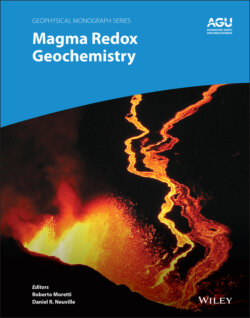Читать книгу Magma Redox Geochemistry - Группа авторов - Страница 26
The fO2 of Planetesimals and the Role of Volatiles.
ОглавлениеPlanetesimals of km‐size diameter formed by condensation and melting from the Solar Nebula. Thus, their chemical composition and oxidation state likely resemble those of the portion of Solar Nebula where they formed, taking into consideration the proposed correlation between heliocentric distance and H2/H2O and C/O ratios reflected in the oxidized nature of the planetesimals upon melting (Grossman et al., 2008). On the basis of N‐body simulations of particle interaction and planetary accretion, the bulk composition of planetesimals and their redox state change with respect to the heliocentric distances in the Solar Nebula. The bodies formed at a distance less than 1.1–1.7 AU exposed to higher temperatures were highly reduced at IW‐4 log units (high C/O ratio) at which all Fe would be stable as metal (plus some Si) whereas the bodies formed beyond 1.1–1.7 AU were more oxidized (low C/O and H2/H2O ratios) with a proportion of Fe as FeO dissolved in silicates (Rubie et al., 2015). Melting of the interior of planetesimals enhanced by C‐O‐H species might also contribute to variations of their redox state with consequent volatile depletion and oxidation (or reduction) of the surrounding mineral matrix before magma can reach the surface and degas (Fu et al., 2017). The variations in oxidation state of the planetesimals are inferred from the intrinsic oxygen fugacity estimated for various meteorite classes (Brett and Sato, 1984), as discussed in Section 2.2.1.3.
